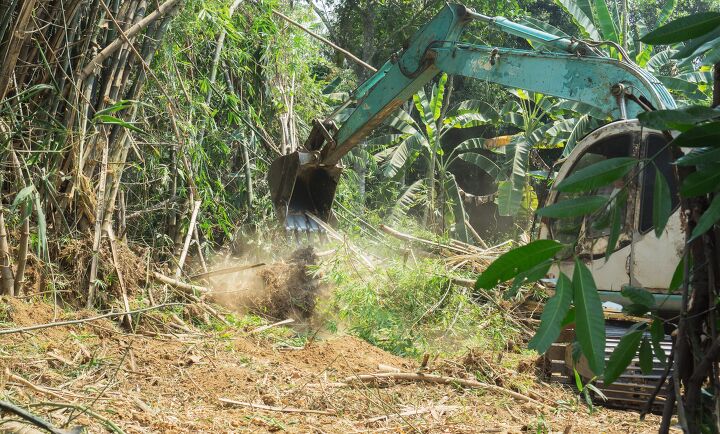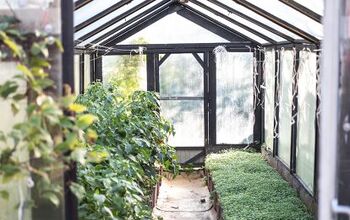How Much Does Bamboo Removal Cost?

Native to Southeast Asia and South America, bamboo is well-known for its visual appeal, often serving as a focal point in landscaping throughout the southern part of the United States. It is also a wonderful screening plant that can make an excellent privacy screen on your property.
Under ideal conditions, bamboo can spread rapidly. In fact, bamboo is one of the fastest-growing plants on earth, with some species reaching full maturity in just 90 days. There is one species of bamboo that can grow a staggering 30 inches a day, or about 1.5 inches an hour!
Attempting to contain “running” bamboo (as opposed to the tamer “clumping” variety) is a common issue for many gardeners. Fortunately, there are a number of persistent natural methods, in addition to chemical attacks, that can be implemented to eradicate the unruly plant. While some bamboo removal techniques can be done by the average homeowner, the easiest and most effective option to remove bamboo is to call in a professional.
The cost to remove bamboo depends on a number of factors including the digging conditions, size of your property, height and density of the bamboo, and whether or not the professional has to dig up the dirt to remove the roots. Another major cost factor is how long the removal is going to take, while major bamboo removals could take anywhere from half a day to more than three days depending on the scope of the project.
With that said, bamboo removal usually costs around $400 for a half-day and $800 for a full day, meaning you could pay as little as $400 or as much as $2,400 depending on the aforementioned factors. However, you’ll likely need to keep poisoning the bamboo shoots for several years after removal to keep it from coming back. This adds to the overall cost of removal.
Why Remove Bamboo?
Most of the issues with bamboo stem from the fact that many species spread very quickly. Invasive bamboo types don’t only grow fast upward, but also outward and can consume between three and five feet of new territory each year. With these types, it’s only a matter of time before the bamboo takes over your yard (and possibly even your neighbors’).
In fact, the problem of invasive bamboo has become so severe that some municipalities now have laws that require homeowners to pay for bamboo removal. With this in mind, here are some of the most common reasons that someone would want (or possibly need) to have bamboo removed:
- The bamboo has extended into areas where it should not grow, such as toward your neighbor’s property or underneath a fence.
- The bamboo was never maintained, which caused the grove to grow larger than originally intended.
- A rhizome barrier was not installed and the underground rhizomes (roots) have started to spread unnoticed into undesirable areas.
- The bamboo was not initially planned accordingly and now doesn’t have enough room to grow. A small space will get overgrown by bamboo very quickly if left unchecked.
- The property has changed ownership and the new owner wants to make changes to the landscape.
- The bamboo died unexpectedly – possibly the planter had no drainage which caused flooding that leads to rotting of the roots and rhizomes.
- The bamboo is in the way of a new proposed fence.
Bamboo Types
The type of bamboo that you have on your property has a major impact on the complexity of the removal and also how much it costs to remove. Generally speaking, there are two main types of bamboo plants that are commonly planted in home landscapes: running bamboos and clumping bamboos. If you know anything about bamboo, you may have heard that running bamboo should be avoided. For most homeowners and amateur gardeners, this is good advice.
Put simply, running bamboo is notorious for spreading faster and wider than clumping bamboo. It is, therefore, considered an invasive plant species. While there are ways to contain both running and clumping bamboo, which also spreads, it is usually best to opt for the clumping variety unless the aggressive growth habit of running bamboo can be put to good use. In fact, most problems that require bamboo removal are caused by the running type.
Running Bamboo vs. Clumping Bamboo
All types of bamboo spread via rhizomes, which are stem-like extensions that run underground horizontally and sprout roots below and new shoots above the surface. Running bamboos are considered monopodial, meaning they have long rhizomes that spread horizontally very fast. Clumping bamboos, on the other hand, are sympodial and have shorter rhizomes that tend to stay closer to their origin point and don’t spread as quickly.
While clumping bamboo types usually grow outward from a central point, running types rapidly extend across a garden or lawn and can pop out in areas where they are unwanted. With that in mind, it’s easy to understand why running bamboos are usually classified as invasive plants and why they are the most common variety that requires removal.
Bamboo goes perfectly with these How Much Does Bamboo Flooring Cost?.
Methods of Bamboo Removal
Taking control of bamboo is often a process that takes many years, depending on how significant the overgrowth is. In some cases, it is possible to handle the bamboo removal yourself with a few tools, patience, and time. Bamboo stalks, also known as culms, are positioned in the soil by their root system – or, rhizomes. With that said, there are a couple of different methods of removal that you can try to eradicate your bamboo overgrowth problem.
1. Cutting and Watering
Some experts claim that continuously cutting and watering bamboo is an effective method for eradicating it. This process involves cutting the plant down to the ground in order to prevent it from completing photosynthesis. In many cases, this method has to be repeated for up to six months in order to accomplish complete eradication. Here’s a brief breakdown of this bamboo removal method:
- Cut the bamboo to the ground level. Use a handsaw or pruners to trim the bamboo down. You can also use a lawnmower to mow immature plants that sit at the periphery of your grove.
- Water the grove. Using a sprinkler or garden hose, thoroughly water the area you’re trying to remove.
- Repeat the process. Continue with this cutting (or mowing) and watering technique until you’ve exhausted the bamboo roots of their energy store. Over time, they won’t send up new shoots anymore. You can then allow any of the remaining rhizomes to rot in the soil underground.
2. Digging
Removing bamboo by digging it up takes a lot of effort, and it may even take a year or more until the bamboo is fully eliminated. With that said, this method is usually only recommended for clumping bamboos or smaller patches of bamboo. In general, clumping bamboo tends to much easier to remove from the soil since the rhizomes are shorter.
- Water the bamboo. Use a sprinkler or garden hose to water the bamboo patch. Let the moisture soak deep into the soil for about a half an hour.
- Cut down the bamboo. Use a handsaw or pruners to cut down the bamboo, leaving only a small amount of greenery extending out from the soil.
- Loosen up the soil. Use a spade shovel to dig around the base of the bamboo plant and loosen up the soil.
- Pull out the plants. At this point, you want to pull the entire plant out of the ground – including the root ball. For running bamboos, be sure to follow the rhizomes as best you can to remove all of the underground root system.
- Break up the rhizomes. Using an ax, break up the rhizomes and remove all of the pieces of them (if possible).
- Repeat the process. Repeat this entire process until you’ve successfully dug up and removed the whole bamboo patch.
- Dig up any new roots. As new bamboo shoots form, dig them up and remove the rhizomes underneath the surface. Continue repeating this process until nothing grows back anymore.
3. Smothering
Another technique for getting rid of pesky bamboo in your yard is to smother the plant using tarps. This method usually takes around two months to be successful. Though, it’s possible for the bamboo to spread beyond the covered perimeter so make sure that you keep a close eye on the situation.
- Cut the bamboo. Start by using a handsaw or pruners to trim the bamboo down to the ground level.
- Cover the area with tarps or garbage bags. Use dark plastic tarps or garbage bag to cover the entire area, securing with rocks or landscaping pins.
- Allow several weeks or months for the tarps to suffocate the plants beneath.
If you notice that rhizomes are extending beyond the tarps and creating new sprouts, follow this process of cutting and covering the sprouts immediately. Or, you can plant other proliferating perennials around the border of the bamboo patch to create a natural barrier that crowds the new shoots that form.
4. Containment
While it’s not entirely a method for removing bamboo, containment will stop your bamboo plants from spreading further while keeping them alive. To do this, dig a trench about 28 inches deep around your bamboo and fill it with a bamboo-resistant barrier made out of concrete, plastic, or metal. This barrier must extend at least two inches above the ground in order to effectively control the rhizomes.
Poisoning Bamboo
While the aforementioned methods do not use any chemicals, sometimes a chemical attack is necessary to eradicate bamboo. You can poison the bamboo patch by applying a glyphosate herbicide or selective grass type herbicide directly to new bamboo growth. Oftentimes, multiple applications of the herbicide are required.
This method is usually used in combination with one of the techniques outlined above. For instance, you may start by digging up the bamboo and then keep a look out for new growth to intervene right away with the herbicide.
Always follow the manufacturer’s instructions carefully when using herbicides and don’t let it touch your skin. To protect your grass and other garden plants, try to be as conscientious as possible about applying the product only to the bamboo.
Professional Bamboo Removal
Whether your bamboo has become too overgrown for you to manage or it’s extended into areas of your property where you don’t want it, hiring an experienced bamboo removal specialist is almost always the best course of action. A professional is going to save you both time and money in the long run, as an inexperienced remover likely doesn’t know the bamboo’s root habits and won’t understand the true scope of the project.
If you hire an inexperienced individual or elect to handle the removal yourself, you’re likely going to be stuck trying to eliminate the bamboo again down the road.
There are essentially two main parts of a bamboo removal job. First, the bamboo needs to be cut down to the ground and disposed of – whether it’s via a chipper or by dumping the bamboo at a local green waste disposal center. After the cutting is complete, poisoning is an effective technique to prevent regrowth. The second part involves what you plan to do with the land after the bamboo has been removed.
When it comes to dealing with bamboo rhizomes, stump grinding tends to be the most cost-effective approach. This method involves the use of a purpose build machine with tungsten carbide teeth to chop and grind up the bamboo roots. Your professional will follow the rhizomes as deep as possible, ensuring that they don’t grow back.
Bamboo Removal Cost Factors
Determining the exact cost of bamboo removal will begin with a site inspection from your bamboo removal specialist. This involves a representative coming out to your home to assess the situation in order to provide you with a quote for the removal. A site inspection is very important, as there are many factors that must be considered to accurately price a bamboo removal job.
The first step in calculating bamboo removal costs is determining how many square meters of bamboo you have and how tall the bamboo is. Additional factors that influence bamboo removal costs include access, type of bamboo, method of removal, and the amount of time the experts will spend removing the bamboo.
Generally speaking, the bigger the machinery that can be used for the removal, the cheaper the bamboo removal job is going to be. You can expect the price to be much higher if your professional has to use manual methods of removal instead.
Bamboo Removal Costs
As we’ve seen thus far, the cost to remove bamboo is dependent on a number of factors and the best way to know exactly how much this service is going to cost is to have a site inspection done by a professional. However, in order to give you a general idea of bamboo removal costs, you can expect to spend around $400 for a half-day and $800 for a full day.
Depending on the size and scope of the job, bamboo removal could take anywhere from a half-day to three days. With that in mind, you could spend as little as $400 or as much as $2,400, if not more, for bamboo removal. However, each situation is unique, so it’s safe to say that bamboo removal could cost between one hundred and several hundreds of dollars.
Regardless of the price, hiring a professional is always going to be better and save you more money in the long run than if you were to handle the bamboo removal on your own.
Bamboo Removal Costs by Major City
To help put things in perspective, the table below outlines the minimum cost, average cost, and maximum cost that homeowners paid for bamboo removal in various major cities across the United States for 2021. These numbers are just estimates and should only be used for budgeting purposes. The best way to find out exactly how much professional bamboo removal service is going to cost is to talk to the experts.
| City | Minimum Cost | Average Cost | Maximum Cost |
| Atlanta, GA | $90 | $426 | $905 |
| Los Angeles, CA | $120 | $571 | $1,211 |
| San Francisco, CA | $127 | $600 | $1,273 |
| Tampa, FL | $94 | $445 | $943 |
| Chicago, IL | $117 | $557 | $1,182 |
| New Orleans, LA | $93 | $442 | $939 |
| Portland, OR | $103 | $492 | $1,045 |
| Seattle, WA | $118 | $562 | $1,193 |
| New York, NY | $143 | $676 | $1,434 |
| Honolulu, HI | $146 | $690 | $1,462 |
Data via. manta.com
Related Questions
What is the best time to remove bamboo from your yard?
Effectively eradicating bamboo involves attaching both the aboveground greenery and the below-ground root system. To do this, you need to begin the removal process in the spring and continue it all the way throughout the plant’s growing cycle. In mild climates where bamboo thrives, this might mean that you have to implement year-round removal efforts to ensure the grove is completely eliminated.
How do you find bamboo rhizomes in the soil?
Using a sifter is an excellent tool to help you sift through the soil to locate stray rhizomes. Even the slightest bit of rhizome that’s left behind could result in a new bamboo shoot.
Does gasoline kill bamboo?
While it’s not an environmentally friendly option, gasoline is an effective weed killer. After you’ve cut back your bamboo, you can spray about a gallon or two of gasoline over the area to limit growth.
Related Articles

Jessica considers herself a home improvement and design enthusiast. She grew up surrounded by constant home improvement projects and owes most of what she knows to helping her dad renovate her childhood home. Being a Los Angeles resident, Jessica spends a lot of her time looking for her next DIY project and sharing her love for home design.
More by Jessica Stone



























